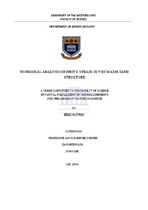Numerical analysis of finite strain in the warm zand structure
Abstract
This research project had two different parts: The first was about the mapping of a section of the Warm Zand Structure and the collection of strain data. The second part focused on the analysis of the finite strain and strain pattern in the Warm Zand Structure. The Warm Zand Structure consists of strongly deformed calc-silicates of the Puntsit formation and feldpathic quarzites of the Goede Hoop formation which gradually change into pure quartzites in some locations. The second phase of folding F2 in the calc-silicates gave open folds. Strain markers are very scarce in the Warm Zand Structure; on the Emmanuel Farm pebbles were not found. However on the Compion Farm, pebbles are scattered and occur in few number. In the study area boudins were found in loose rocks hence they could not be used to estimate orientation of the XY plane of the strain ellipsoid (Ramsay, 1967). Folds on the other hand was common and was used to investigate the bulk shortening of the rocks and to understand the kinematical folding mechanisms involved in the folding process of the rock in the Warm Zand Structure. The strain contour map and the Sherwin and Chapple graph were used to investigate the strain and viscosity contrast respectively. The viscosity contrast of the folds collected in the Puntsit falls between 100-53 whereas the bulk shortening on the other hand is between 60-53%. The values of the shortening found agree with those found by van Bever Donker (1980). The numerical modelling on the other demonstrated that in addition to layer parallel shortening and the flattening mention by van Bever Donker (1980) Tangential Longitudinal Strain and Flexural Flow are also involved in the folding process of the fold collected in the Puntsit Formation.

